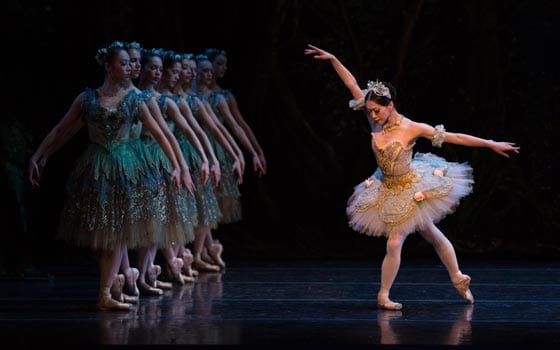

arts41b.jpg
A timeless love story. Ravishing music. Superb choreography. One of the most beautiful and moving works of classical ballet, “The Sleeping Beauty” has it all. The Boston Ballet brings its strengths to the stage in a captivating production at the Boston Opera House through April 7.
Marius Petipa’s “The Sleeping Beauty,” is alive and well with the power of fairy tales to captivate, excite and stir emotion.
The dancing is not merely decorative — although there is plenty of eye candy in its interwoven lace-like lines. The choreography also expresses individual personalities and dramatizes a battle between light and darkness in which desire, tempered but not muted, triumphs.
The Boston Ballet has presented this production twice before, in 2005 and 2009. The production is faithful to the original choreography crafted by Petipa in 1890, when he was ballet master of the Imperial Theatre (today, the Mariinsky Ballet) in St. Petersburg, Russia. The Boston Ballet Orchestra, conducted by its music director, Jonathan McPhee, performs the magnificent score by Peter Ilyich Tchaikovsky.
Deft lighting by John Cuff refines faces and intimate gestures as well as the ballet’s panoramic formations and grand stage pictures, as screens rise and fall to transform a stately garden into a forest or a vine-shrouded castle.
The company’s dancers rotate among the roles in the production, which lasts about two hours and 45 minutes with two intermissions.
On Friday evening, Misa Kuranaga and Jeffrey Cirio were well matched as Princess Aurora and Prince Désiré. Both are small in stature and project unforced sweetness.
In the prologue, the king and queen christen their infant princess in a garden overlooking a grand pathway of trees. A clique of dancing fairies presents gifts, led by the Lilac Fairy, performed by an elegant and commanding Lia Cirio. The mood changes with the arrival of her nemesis, the evil fairy Carabosse, attended by a quartet of horned, rat-like creatures. A beauty with a mane of red curls, pasty white makeup and a sparkling black gown, Erica Cornejo’s Carabosse is an electrifying presence, exuding Goth glamour.
Overlooked on the guest list, Carobosse vents her fury with a curse: On her 16th birthday, Princess Aurora will prick her finger on a spindle and die. The Lilac Fairy concocts an antidote: Instead of dying, the princess will fall into a 100-year sleep and then wake to the kiss of a handsome prince.
Act I is the 16th birthday party of Princess Aurora, where an ensemble of maidens bearing garlands of flowers forms a human carousel. The princess’ high-spirited solo is an aria to youthful joy. The choreography and music slow to reveal her jubilant and tender nature. Textured melodies of the glockenspiel, violins, piano and harp accompany her light-hearted pirouettes and leaps. Kuranaga’s performance makes us care about this young woman.
A test of a dancer’s skill as well as the grace and self-possession of a young lady coming of age, the Act I Rose Adagio sequence is one of the most challenging in classical ballet. As she greets a succession of four princes, the princess withdraws her hand from one suitor and extends it to the next, all the while standing tiptoe on one foot.
A hooded Carabosse sneaks in and presents the princess with a bejeweled spindle. Kuranaga shows Aurora’s bewilderment and bravery as she pricks her finger, shrivels and then resumes dancing only to drop, apparently dead. True to her word, the Lilac Fairy casts the princess and the court into a spell of protective slumber and wraps the castle in vines.
In Act II, 100 years later, Jeffrey Cirio’s Prince Désiré is alone in a forest. He has sent his companions off to hunt without him. His face is downcast — but not for long. In an enchanting scene, the Lilac Fairy arrives on a cloud of seafoam, transported in a blue sailboat adorned with a crescent moon. She tells the prince the story of Aurora, and conjures a vision of her. Recognizing the princess as the fulfillment of his longing, the prince travels with the Lilac Fairy to the castle. After a final skirmish with Carabosse, he enters and with a kiss awakens Aurora and her kingdom.
Act III celebrates the wedding. Among the guests are fairy tale royalty, including Puss n’ Boots, Little Red Riding Hood and the Wolf. Particularly beguiling is the sassy duet between Puss n’ Boots and the White Cat (Rie Ichikawa and Altan Dugaraa) who nuzzle, rub and slither their way down the receiving line.
Aurora and Désiré perform a sublime pas de deux. Kuranaga conveys Aurora’s new serenity. The spectacular leaps of Cirio’s prince are more than a bravura demonstration. They are an expression of joy. The two unite in a pose of astonishing beauty. Princess Aurora rises aloft in the arms of Prince Désiré, her legs intertwined and branching upward in an image of exaltation.






